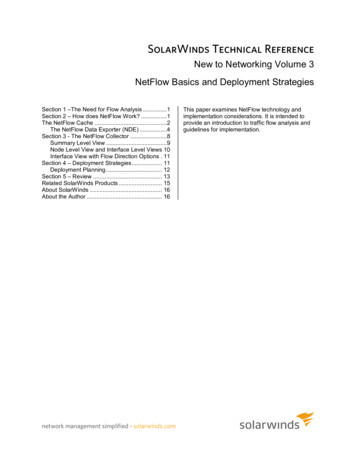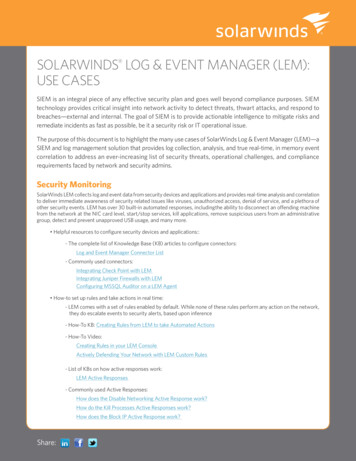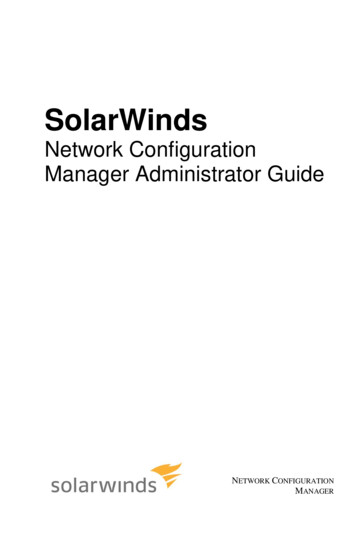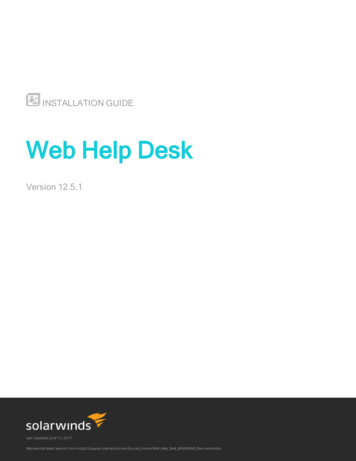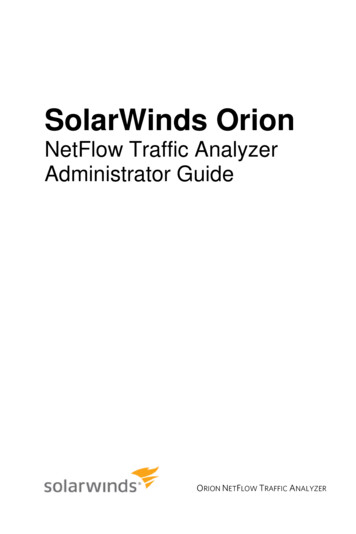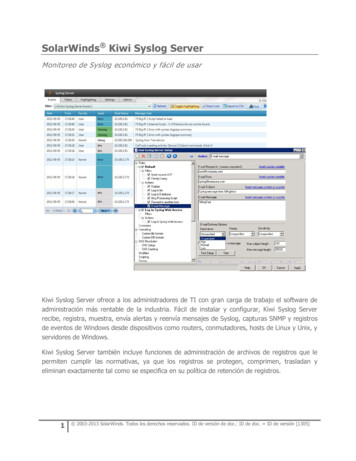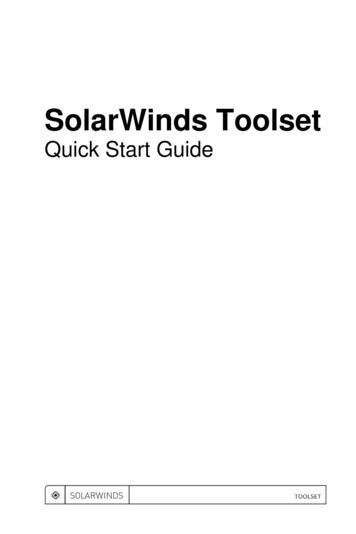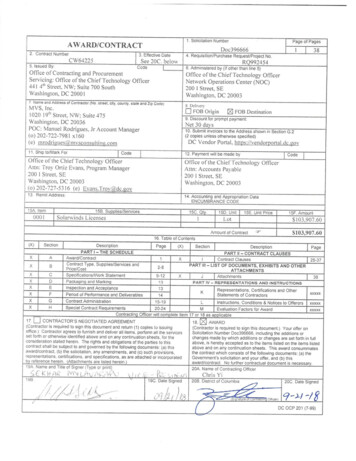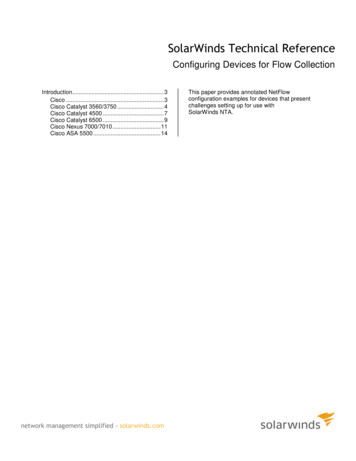
Transcription
SolarWinds Technical ReferenceConfiguring Devices for Flow CollectionIntroduction. 3Cisco . 3Cisco Catalyst 3560/3750 . 4Cisco Catalyst 4500 . 7Cisco Catalyst 6500 . 9Cisco Nexus 7000/7010 . 11Cisco ASA 5500 . 14network management simplified - solarwinds.comThis paper provides annotated NetFlowconfiguration examples for devices that presentchallenges setting up for use withSolarWinds NTA.
Configuring Devices for Flow Collection 2Copyright 1995-2014 SolarWinds Worldwide, LLC. All rights reserved worldwide.No part of this document may be reproduced by any means nor modified, decompiled, disassembled, published or distributed, inwhole or in part, or translated to any electronic medium or other means without the written consent of SolarWinds. All right, title andinterest in and to the software and documentation are and shall remain the exclusive property of SolarWinds and its licensors.SolarWinds Orion , SolarWinds Cirrus , and SolarWinds Toolset are trademarks of SolarWinds and SolarWinds.net and theSolarWinds logo are registered trademarks of SolarWinds All other trademarks contained in this document and in the Software arethe property of their respective owners.SOLARWINDS DISCLAIMS ALL WARRANTIES, CONDITIONS OR OTHER TERMS, EXPRESS OR IMPLIED, STATUTORY OROTHERWISE, ON SOFTWARE AND DOCUMENTATION FURNISHED HEREUNDER INCLUDING WITHOUT LIMITATION THEWARRANTIES OF DESIGN, MERCHANTABILITY OR FITNESS FOR A PARTICULAR PURPOSE AND NONINFRINGEMENT. INNO EVENT SHALL SOLARWINDS, ITS SUPPLIERS OR ITS LICENSORS BE LIABLE FOR ANY DAMAGES, WHETHERARISING IN TORT, CONTRACT OR ANY OTHER LEGAL THEORY EVEN IF SOLARWINDS HAS BEEN ADVISED OF THEPOSSIBILITY OF SUCH DAMAGES.The SolarWinds, the SolarWinds & Design, ipMonitor, LANsurveyor, Orion, and other SolarWinds marks, identified on theSolarWinds website, as updated from SolarWinds from time to time and incorporated herein, are registered with the U.S. Patent andTrademark Office and may be registered or pending registration in other countries. All other SolarWinds trademarks may becommon law marks or registered or pending registration in the United States or in other countries. All other trademarks orregistered trademarks contained and/or mentioned herein are used for identification purposes only and may be trademarks orregistered trademarks of their respective companies. Microsoft , Windows , and SQL Server are registered trademarks ofMicrosoft Corporation in the United States and/or other countries.Revised: 5/28/2014network management simplified - solarwinds.com
Configuring Devices for Flow Collection 3IntroductionThe sections of this document—organized alphabetically by vendor—provide NetFlow configurationexamples for network devices that sometimes present problems in preparing them to work withSolarWinds NetFlow Traffic Analyzer.CiscoCisco Catalyst 3560/3750Cisco Catalyst 4500Cisco Catalyst 6500Cisco Nexus 7000Cisco ASA 5500For detailed information about setting up devices to use with SolarWinds NetFlow Traffic Analyzer, referto the section “Setting up Network Devices to Export NetFlow Data” in the SolarWinds NetFlow TrafficAnalyzer Administrator Guide.network management simplified - solarwinds.com
Configuring Devices for Flow Collection 4Cisco Catalyst 3560/3750Standard 3750 and 3560 switches do not support NetFlow. The 3750-X and 3560-X L3 switches onlysupport NetFlow if they have the C3KX-SM-10G Service module; and in this case the only option is usingFlexible NetFlow.The tasks involved in creating a Flexible NetFlow configuration are:1. Enabling ingress and egress on the C3KX-SM-10G module uplink ports.2. Creating and configuring the flow record.3. Creating and configuring the flow exporter(s).4. Creating a flow monitor to bind the flow record to the exporter.5. Applying the flow monitor to the appropriate interface on the device.The following configuration example creates a custom flow record and flow monitor. Each section in theexample—flow record, flow exporter, flow monitor—includes notes that explain what the commands aredoing.Interface Setup!interface TenGigabitEthernet1/1/1switchport trunk encapsulation dot1qswitchport mode trunkip flow monitor NetFlow inputip flow monitor NetFlow output!interface TenGigabitEthernet1/1/2switchport trunk encapsulation dot1qswitchport mode trunkip flow monitor NetFlow inputip flow monitor NetFlow outputYou must enable ingress and egress on the C3KX-SM-10G module uplink ports since they are the onlyinterfaces on the module that support NetFlow export functionality.Flow RecordFlow record NetFlowmatch ipv4 tosmatch ipv4 protocolmatch ipv4 source addressmatch ipv4 destination addressmatch transport source-portmatch transport destination-portcollect interface input snmpcollect interface output snmpcollect counter bytescollect counter packetsnetwork management simplified - solarwinds.com
Configuring Devices for Flow Collection 5The flow record part of this configuration example creates the record called “NetFlow” and uses thematch ipv4, match transport, and collect commands to define the key fields in the record by which flowdata will be processed. For more information on these commands, see this Cisco command reference.Flow Exporterflow exporter NetFlow-to-Oriondestination 10.10.10.10source vlan254transport udp 2055export-protocol netflow-version 9The flow exporter part of the configuration examples defines an exporter (called “NetFlow-to-Orion”) thedestination (the IP address of the Orion server) to which flow data will be exported, the source interface(here called ‘vlan254’; it’s the interface with the IP address with which Orion is managing the device) fromwhich flow data will be exported, the transport protocol and port (udp, 2055—Orion’s collection port)through which the flow data will pass, and the NetFlow export protocol (netFlow version 9) that theNetFlow collector should expect and use to process the data.Flow Monitorflow monitor NetFlow-Monitordescription Original Netflow capturesrecord ipv4exporter NetFlow-to-Orioncache timeout inact 10cache timeout act 5interface TenGigabitEthernet1/1/1interface TenGigabitEthernet1/1/2ip flow monitor NetFlow-Monitor inputThe flow monitor part of the configuration example creates a monitor (called “NetFlow-Monitor”) that usesthe record and exporter commands to bind the flow record (ipv4) to the flow exporter (NetFlow-to-Orion)you already created. The interface command defines the interface (two of them, in this case) to which theflow monitor NetFlow-Monitor applies; and the ip flow monitor command specifies the capture of ingressdata (input) on the two specified interfaces.network management simplified - solarwinds.com
Configuring Devices for Flow Collection 6The overall configuration without annotations looks like this:flow exporter NetFlow-to-Oriondestination 10.10.10.10source vlan254transport udp 2055flow exporter NetFlow-to-Oriondestination 10.10.10.10source vlan254transport udp 2055export-protocol netflow-v5flow monitor NetFlow-Monitordescription Original Netflow capturesrecord ipv4exporter NetFlow-to-Orioncache timeout inact 10cache timeout act 5interface TenGigabitEthernet1/1/1interface TenGigabitEthernet1/1/2ip flow monitor NetFlow-Monitor inputFor detailed information on available commands and their use see the Cisco Flexible NetFlow CommandReference.network management simplified - solarwinds.com
Configuring Devices for Flow Collection 7Cisco Catalyst 4500For processing NetFlow this switch uses Supervisor Engine 5 or Supervisor Engine 7. With SE 5 theCisco 4500 supports a regular NetFlow (v5) configuration; but with SE 7 the device must be configuredfor Flexible NetFlow. Note: Supervisor Engine 6 does not supportSupervisor Engine 5For this setup of the device you can use a regular NetFlow configuration such as:ip route-cache flow infer-fieldsip flow ingress infer-fieldsip flow ingress layer2-switchedConfiguring Devices for NetFlow 5ip flow-export source port with the IP address managed in Orion ip flow-export version 5ip flow-export destination Orion Server IP address 2055ip flow-cache timeout active 1ip flow-cache timeout inactive 45snmp-server ifindex persistSupervisor Engine 7A Flexible NetFlow configuration consists in a flow record, a flow exporter, and a flow monitor, each ofwhich includes parameters that you assign appropriate values. For information on the advantages ofusing Flexible NetFlow, see this Cisco FAQ.The tasks involved in creating a Flexible NetFlow configuration are:1. Creating and configuring the flow record.2. Creating and configuring the flow exporter(s).3. Creating a flow monitor to bind the flow record to the exporter.4. Applying the flow monitor to the appropriate interface on the device.The following configuration example creates a custom flow record and flow monitor. Each section in theexample—flow record, flow exporter, flow monitor—includes notes that explain what the commands aredoing.Flow Recordflow record ipv4! match ipv4 tosmatch ipv4 protocolmatch ipv4 destination addressmatch transport source-portmatch transport destination-portmatch interface inputcollect interface outputcollect counter bytescollect counter packetsThe flow record part of this configuration example creates the record called “ipv4” and uses the matchipv4, match transport, and collect commands to define the key fields in the record by which flow datawill be processed. For more information on these commands, see this Cisco command reference.network management simplified - solarwinds.com
Configuring Devices for Flow Collection 8Flow Exporterflow exporter NetFlow-to-Oriondestination 10.10.10.10source vlan254 (interface with which Orion is managing the device)transport udp 2055 (Orion’s collection port)export-protocol netflow-v5The flow exporter part of the configuration examples defines an exporter (called “NetFlow-to-Orion”) thedestination (the IP address of the Orion server) to which flow data will be exported; the source interface(with which IP address with which Orion is managing the device) from which flow data will be exported;the transport protocol and port (udp, 2055—Orion’s collection port) through which the flow data will pass;and the NetFlow export protocol (NetFlow v5) that the NetFlow collector should expect and use toprocess the data.Flow Monitorflow monitor NetFlow-Monitordescription Original Netflow capturesrecord ipv4exporter NetFlow-to-Orioncache timeout inact 10cache timeout act 5interface vlan254ip flow monitor NetFlow-Monitor inputThe flow monitor part of the configuration example creates a monitor (called “NetFlow-Monitor”) that usesthe record and exporter commands to bind the flow record (ipv4) to the flow exporter (NetFlow-to-Orion)you already created. The interface command defines the interface (vlan254, in this case) to which theflow monitor NetFlow-Monitor applies and ip flow monitor command specifies the capture of ingress data(input).network management simplified - solarwinds.com
Configuring Devices for Flow Collection 9The overall configuration without annotations looks like this:flow record ipv4! match ipv4 tosmatch ipv4 protocolmatch ipv4 destination addressmatch transport source-portmatch transport destination-portmatch interface inputcollect interface outputcollect counter bytescollect counter packetsflow exporter NetFlow-to-Oriondestination 10.10.10.10source vlan254transport udp 2055export-protocol netflow-v5flow monitor NetFlow-Monitordescription Original Netflow capturesrecord ipv4exporter NetFlow-to-Orioncache timeout inact 10cache timeout act 5interface vlan254ip flow monitor NetFlow-Monitor inputFor detailed information on available commands and their use see the Cisco Flexible NetFlow CommandReference.Cisco Catalyst 6500The following example includes annotations that explain the requirements for successfully configuringNetFlow on this device.ip route-cache flowThis command enables fast switching (CEF) on the device. On this device NetFlow is monitored only fortraffic that is fast-switched (CEF).mlsmlsmlsmlsmlsip multicast flow-stat-timer 9aging long 64aging normal 32flow ip interface-fullnde sender version 5These Multilayer Switching commands set the named timer (ip multicast flow stat timer), the agingintervals for data in the flow cache (aging long, aging normal) by which export should occur, the flowmask (flow ip); and also configure flow export (nde sender version) as NetFlow version 5 on the PolicyFeature Card (PFC).network management simplified - solarwinds.com
Configuring Devices for Flow Collection 10ipipipipIpflow-export source IP Addressflow-export version 5flow-export destination IP Address(Orion NPM server) 2055flow ingress layer2-switched vlan x, y, z (separate each VLAN with a comma)flow ingressThese commands set the flow export source (ip flow-export source; the IP address must be monitoredin Orion), the flow version (ip flow export version), the flow export destination (ip flow-exportdestination; the IP of the Orion server with default port 2055), and enable NetFlow (ip flow ingresslayer2-switched) for Layer 2 switched traffic and Layer 3 traffic (ip flow ingress) on the MultilayerSwitch Feature Card (MSFC).The overall configuration without annotations looks like this:ip route-cache flowmls ip multicast flow-stat-timer 9mls aging long 64mls aging normal 32mls flow ip interface-fullmls nde sender version 52-Configuring Devices for NetFlowip flow-export source IP Addressip flow-export version 5ip flow-export destination IP Address(Orion NPM server) 2055ip flow ingress layer2-switched vlan x, y, z (separate each VLAN with a comma)Ip flow ingressnetwork management simplified - solarwinds.com
Configuring Devices for Flow Collection 11Cisco Nexus 7000/7010This device require a Flexible NetFlow configuration. The following example creates a custom flow recordand flow monitor, and applies the monitor to appropriate interfaces. Each section in the example—flowrecord, flow exporter, flow monitor, and configuration on interfaces—includes notes that explain what thecommands are doing.Sample Flexible NetFlow ConfigurationFlow Recordflow record OrionNetFlowmatch ip tosmatch ip protocolmatch ipv4 source addressmatch ipv4 destination addressmatch transport source-portmatch transport destination-portmatch interface input (Auto Added)match interface output (Auto Added)match flow direction (Auto Added)collect counter bytescollect counter packetsThe flow record part of this configuration example creates the record called “OrionNetFlow” and uses thematch (ipv4, interface, transport) and collect (counter) commands to define the key fields in the recordby which flow data will be processed. For more information on these commands, see this Cisco commandreference.Flow Exporterflow exporter NetFlow-to-Oriondestination 10.10.10.10 (Orion Server)source vlanXXX (Required)transport udp 2055 (Orion’s collection port, 2055 by default. You can use any other port, but you need to add itas a collector in NTA.)version 9 (This command will put you into another configuration mode - have option to add additional conditions,such as the following line.)template data timeout 60Note: The template data timeout 60 command ensures that the template is exported every 1 minute.The default setting is 600 s.The flow exporter part of the configuration examples defines an exporter (called “ NetFlow-to-Orion”) thedestination to which flow data will be exported, the source interface (vlanXXX) from which flow data willbe exported, the transport protocol and port (udp, 2055) through which the flow data will pass, and theNetFlow export protocol (Version 9) that the NetFlow collector should expect and use to process thedata.network management simplified - solarwinds.com
Configuring Devices for Flow Collection 12Flow Monitorflow monitor NetFlow-Monitordescription xxxxexporter NetFlow-to-Orionrecord OrionNetFlowConfiguration on InterfacesNow you need to apply the monitor to appropriate interfaces.interface Ethernet2/1ip flow monitor NetFlow-Monitor inputip flow monitor NetFlow-Monitor outputThe flow monitor part of the configuration example creates a monitor (called “ NetFlow Monitor”) thatuses the record and exporter commands to bind the flow record (OrionNetFlow) to the flow exporter(NetFlow-to-Orion) you already created. The interface command defines the interface (Ethernet2/1)to which the flow monitor NetFlow Monitor applies and ip flow monitor command specifies the captureof both ingress (input) and egress (output) data.Note: You can enter a VLAN range prior to entering the command above (i.e. vlan 1 – 3967 instead ofeach vlan separately).network management simplified - solarwinds.com
Configuring Devices for Flow Collection 13The overall configuration without annotations looks like this:flow record OrionNetFlowmatch ip tosmatch ip protocolmatch interface inputmatch ipv4 source addressmatch ipv4 destination addressmatch transport source-portmatch transport destination-portmatch interface inputmatch interface outputmatch flow directioncollect counter bytescollect counter packetsflow exporter NetFlow-to-Oriondestination 10.10.10.10source vlanXXXtransport udp 2055version 9template data timeout 60flow monitor NetFlow-Monitordescription xxxxrecord OrionNetFlowexporter NetFlow-to-Orioninterface Ethernet2/1ip flow monitor NetFlow-Monitor inputip flow monitor NetFlow-Monitor outputnetwork management simplified - solarwinds.com
Configuring Devices for Flow Collection 14Cisco ASA 5500Besides the usual target address for flow exports, devices in this series require a service policy thatenables flow data to be exported.The following example includes annotations that explain the requirements for successfully configuringNetFlow on this device.ip flow-export destination inside 1.1.1.1 2055This command sets the export target IP address and port (NTA collector at 1.1.1.1 2055) and designatesit as inside the network that includes the ASA device.ip flow-export template timeout-rate 1This command sets the timeout of the current v9 template(in this case it is set to 1 minute) and results in re-sending the template with the flow data as soon as thetimeout is reached.ip flow-export delay flow-create 60This command delays the creation of a NetFlow record and so delays exporting flow data until thenumber of seconds (60 in this case) are reached.ip access-list netflow-export extended permit ip any anyThis command creates an access list (access-list) called netflow-export that the device to export flowrecords from any IP address (outside interface) to any IP address (in this case, the result is that exportswill go to the NetFlow collector target as specified in the ip flow-export destination command)class-map netflow-export-classmatch access-list netflow-exportpolicy-map global policyclass netflow-export-classservice-policy global policy globalflow-export event-type all destination 1.1.1.1Note: If a global policy already exist just add the NetFlow policy map to it.These commands create the Modular QoS traffic management setup to enable flow packet traffic to getout of the device’s outside interfaces and make it to the targeted NetFlow collector:1. Creates a traffic class (class-map) called netflow-export-class2. Specifies that the access list netflow-export should be applied (match) to this class3. Selects (policy-map) default traffic inspection rules (global policy) for flow traffic4. Applies (service-policy) those rules to all interfaces (global) on the device through which flowpackets is transferred5. Specifies that all events that trigger creation of flow records should be targeted at the NTAcollector (1.1.1.1).network management simplified - solarwinds.com pag
Cisco Catalyst 3560/3750 Standard 3750 and 3560 switches do not support NetFlow. The 3750-X and 3560-X L3 switches only support NetFlow if they have the C3KX-SM-10G Service module; and in this case the only option is using Flexible NetFlow. The tasks involved in creating a Flexible NetFlow configuration are: 1.
